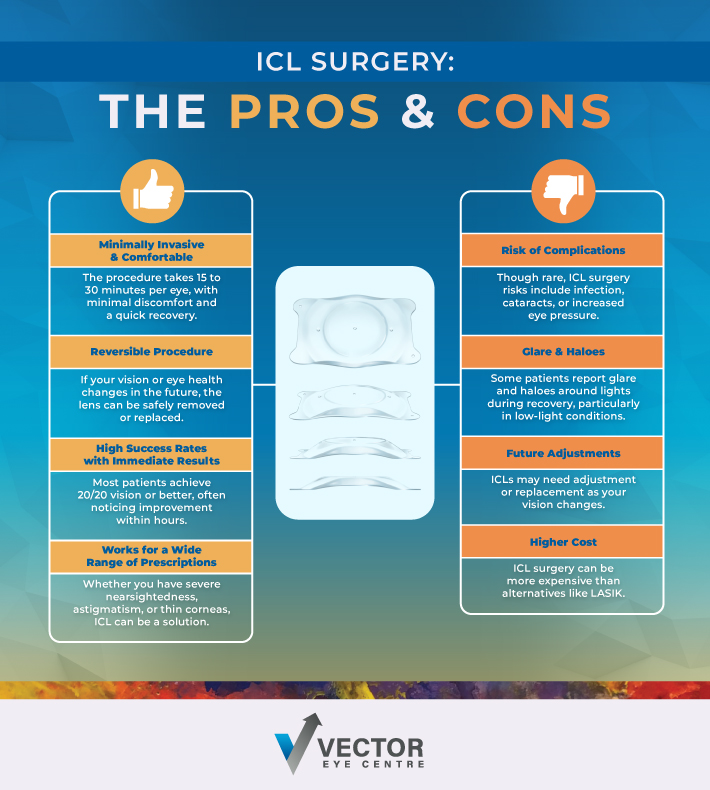Having the gift of clear vision without daily reliance on glasses or contact lenses can be life-changing for many people. Implantable Collamer Lens (ICL) surgery is an alternative to laser eye surgery procedures like LASIK to permanently correct vision.
ICL surgery offers clear benefits such as improved vision, reversibility, and suitability for those with high prescriptions or thin corneas. However, like any surgery, it comes with potential risks. Not often, ICL may lead to changes in glare or the need for future adjustments.
What Is ICL Surgery?
ICL surgery is a minimally invasive vision correction procedure that involves inserting a biocompatible lens into your eye to improve vision.
Unlike LASIK or PRK, ICL surgery does not reshape your cornea. Instead, the lens works with your natural eye structures to correct nearsightedness, farsightedness, and even astigmatism.
ICL surgery is often referred to as “lens replacement surgery,” but technically, your eye’s natural lens is not removed—the implanted lens is simply added to enhance your vision.
This procedure is known for its high success rate and rapid recovery time, making it an increasingly popular choice among people looking for a long-term solution for vision correction.
The Pros of ICL Surgery
ICL surgery offers several impressive benefits that set it apart from other vision correction options.
Minimally Invasive & Comfortable
One of the standout features of ICL surgery is its minimally invasive nature. The procedure involves a tiny incision and takes about 10 to 15 minutes per eye. Patients typically experience little to no discomfort during surgery, with a quick recovery timeline compared to other more invasive surgeries.
Reversible Procedure
Unlike LASIK, ICL surgery is reversible. If your vision or eye health changes in the future, the lens can be safely removed or replaced. This also makes the procedure particularly appealing for people who might want to make adjustments down the line.
High Success Rates with Immediate Results
ICL surgery boasts exceptional success rates, with the majority of patients achieving 20/20 vision or better. Visual improvement is often noticeable within hours of the procedure.
Works for a Wide Range of Prescriptions
Whether you have severe nearsightedness, astigmatism, or thin corneas, ICL can be a solution when other procedures, like LASIK, aren’t suitable.
Suitable for Dry Eyes

Unlike laser-based surgeries, which can sometimes exacerbate dry eye symptoms, ICL surgery minimally damages your eye’s corneal nerves or tear production, making it a safer option for people prone to dryness.
The Cons of ICL Surgery
While ICL surgery provides many advantages, it’s equally important to understand its limitations and potential risks.
Risk of Complications
Although rare, there are potential risks associated with ICL surgery, including infection, cataract formation, or an increase in eye pressure.
Most risks are manageable if promptly addressed, but it’s essential to be aware beforehand. Follow-up appointments can also help monitor changes in vision and eye health.
Glare & Haloes
Some patients report experiencing glare and haloes around lights, particularly in low-light conditions. While these issues are more common in the initial recovery period, they may persist for some individuals.
Future Adjustments or Additional Surgery
Since ICLs work with your natural lens, the lens may need to be adjusted or replaced as your vision changes over time. Additionally, since the natural lens isn’t replaced, people may also still require cataract surgery later in life.
Higher Cost
ICL surgery can be more expensive than alternatives like LASIK. You’ll want to weigh this investment against its long-term benefits.
Not Suitable for Everyone
Certain medical conditions, such as chronic eye diseases or unstable prescriptions, may mean you’re not a good candidate for ICL surgery.
Who Is an Ideal Candidate for ICL Surgery?
It’s important to meet several criteria to determine if this surgery is the right fit. Some things to consider include:
- Age: The best age for ICL surgery is typically between 20 and 45, when your vision is most stable. Candidates should have had a stable prescription for at least 1 year before surgery.
- Eye health: You should not have any existing eye conditions, such as glaucoma, cataracts, or eye infections. People with thin corneas, however, may opt for ICL since it leaves the corneal structure intact.
- Prescription range: ICL is often recommended for patients with higher degrees of nearsightedness, farsightedness, and astigmatism.
If you’re uncertain about your candidacy, consult an eye care professional to assess your unique situation.
The ICL Surgery Process
Understanding what happens during surgery can help you make an informed decision.
- The surgeon applies numbing and dilating eye drops, followed by a small incision in your cornea.
- The ICL is carefully inserted through the incision and placed behind your iris, where it unfolds naturally.
- The procedure is quick, reported by many to be pain-free, and typically completed within 15 minutes.
Recovery & Results
Recovery is typically swift, but following post-surgery care guidelines is key to optimal outcomes. Most patients experience noticeably better vision within a day. However, full adjustment and clarity may take a couple of weeks.
Use prescribed eye drops to prevent infections and inflammation. Attend follow-up visits to monitor your progress. While ICL surgery significantly improves vision, it’s worth noting that your natural vision may still change over time due to age-related factors.
Empower Your Vision with ICL
ICL surgery presents a promising option for those seeking to improve their vision without permanently altering their eyes. By weighing the pros and cons carefully and consulting with a professional, you can make an informed decision.
If you’re considering more permanent solutions to correct your vision, we can help. Contact Vector Eye Centre today to learn more, or call 587-848-3520 to book a refractive assessment.



